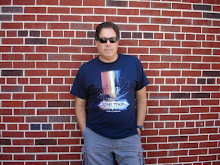Sunday, March 15, 2020
TOUCH OF EVIL
(February 1958, U.S.)
I am writing this post on Orson Welles's 1958 theatrical version of the film...
It took me some time beyond CITIZEN KANE to fully realize the genius behind many of Orson Welles's films, including TOUCH OF EVIL. Believe it or not, I was barely aware of the film until it was featured in the 1995 John Travolta film GET SHORTY. The combination of Travolta's enthusiasm and the image of the Los Angeles movie theater marquee peaked my interest in this American film noir classic. Not long after, I got the chance to see it on screen at a revival theater in Manhattan's Greenwich Village in a double bill with DOUBLE INDEMNITY (that was a great day at the movies!). Then in 1998, it was re-released as an extended and re-cut version remaining faithful to Welles's original vision, as it was described in a fifty-eight page letter he wrote to Universal Studios at the time. It was, of course, a pleasure to watch this film again on screen, but I've always (with only a few exceptions) clung to the original theatrical versions of popular movies.
Charlton Heston plays his version of a Mexican drug enforcement official named Mike Vargas, just newly married to Susie (played by Janet Leigh). While walking along the U.S.-Mexico border, a time bomb is planted inside the trunk of a car and explodes on the U.S. side of the border, killing a man and his young female lover. Realizing the political implications of a Mexican bomb exploding on American soil, Vargas proceeds into the investigation despite having no official authoritative jurisdiction. Several police officials arrive on the scene, including obese and sloppy police captain Hank Quinlan (played by Orson Welles himself). The prime suspect in the bombing is a young Mexican named Sanchez who was secretly married to the car bomb victim's daughter. Sanchez is roughly interrogated by Quinlan and the other cops and eventually framed for his arrest by two sticks of dynamite planted in a shoe box in his apartment. Vargas accuses Quinlan of planting the evidence and soon suspects that Quinlan has been planting evidence and framing suspects for years to help secure convictions. Vargas's claims are dismissed due to his presumed just-biased in favor of fellow Mexicans.
Meanwhile, Susie is holed up alone at a remote American motel to escape the trouble brewing amidst the investigation and the criminal intentions of crime family boss Uncle Joe Grandi. The motel is owned by Grandi and proven to be unsafe when Grandi's relatives take over and terrorize Susie by overdosing her with drugs and planting drugs around her unconscious body. Grandi is double-crossed and strangled by Quinlan, leaving Susie in the room with the dead body, all as an attempt to discredit Vargas and his suspicions. A drunk Vargas is confronted about his past history of tainted evidence by his police partner, while Vargas is not far behind recording the conversation on foot. Qunilan drunkenly admits to planting evidence on those he believed to be guilty. But during the outdoor recorded conversation, Quinlan hears an echo from the secret microphone and suspects betrayal by his partner, as well as Vargas's presence nearby. Qunilan shoots his partner with Vargas's' gun (stolen earlier in the film) and prepares to shoot Vargas himself, but is instead shot by the dying partner. Like the filthy man he is (was), Quinlan falls and dies in a pool of filthy wastewater. The film ends with a simple implication that men are just men, and it doesn't matter what we say about them in the end.
Despite being a film that Welles initially didn't want to make, it has all the styles and traditions that make his films great, including the overlapping dialogue and multiple perspective camera shots and cinematography. Orson Welles himself plays a role that may also be considered semi-autobiographical, in that he not only acknowledges his own changing physical appearance, but also a man who may be confronting old feuds and past demons, exhibiting an obsessive need for control of everything and everyone around his professional career and personal life.
However many versions of TOUCH OF EVIL there may be, or however it's been judged throughout the history of cinema, it still remains a shining example of Orson Welles's brilliance.
Favorite line or dialogue:
Tanya: "Isn't somebody gonna come and take him away?"
Al Schwartz: "Yeah, in just a few minutes. You really liked him didn't you?"
Tanya: "The cop did...the one who killed him...he loved him."
Schwartz: "Well, Hank was a great detective all right."
Tanya: "And a lousy cop."
Schwartz: "Is that all you have to say for him?"
Tanya: "He was some kind of a man. What does it matter what you say about people?"
Schwartz: "Goodbye, Tanya."
Tanya: "Adiós."
Subscribe to:
Post Comments (Atom)



No comments:
Post a Comment